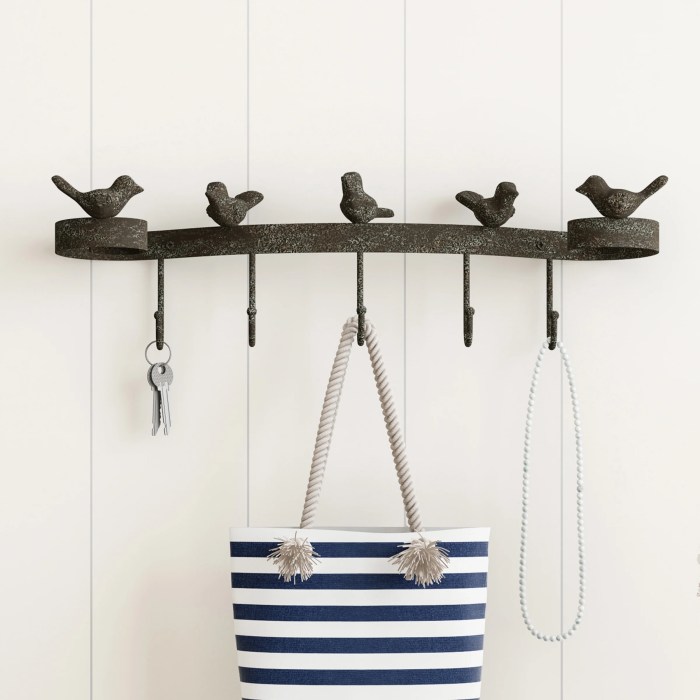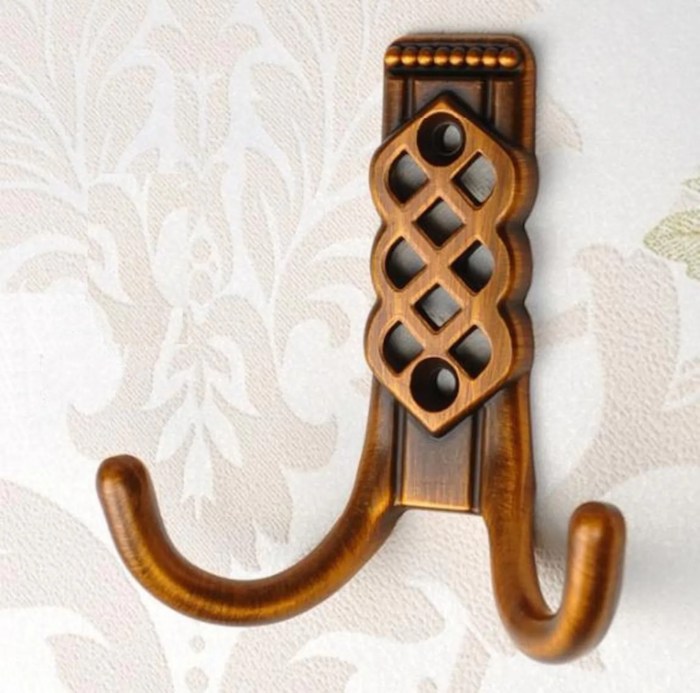Decorative wall hooks transform ordinary spaces into stylish havens. Far beyond mere utilitarian items, they offer a blend of practicality and aesthetic appeal. From rustic farmhouse charm to sleek modern minimalism, the right hooks can enhance any room’s décor while providing convenient storage for coats, bags, keys, and more. This guide explores the diverse world of decorative wall hooks, covering their styles, applications, installation, and integration into current interior design trends.
We delve into the various materials, finishes, and designs available, helping you choose the perfect hooks to complement your personal style and home aesthetic. Whether you’re looking to add a touch of vintage elegance, a splash of bold color, or subtle minimalist accents, this comprehensive guide will empower you to select and install wall hooks that seamlessly blend form and function.
Types of Decorative Wall Hooks

Decorative wall hooks offer a blend of functionality and aesthetics, transforming mundane spaces into personalized havens. Their versatility allows them to seamlessly integrate into various interior design styles, adding a touch of character and charm to any room. The choice of wall hook depends greatly on the desired style, available space, and the overall décor of the area.
Material Classification of Decorative Wall Hooks
The material of a decorative wall hook significantly impacts its durability, aesthetic appeal, and overall cost. Different materials lend themselves to different styles and finishes.
| Material | Style Examples | Description | Example Image Description |
|---|---|---|---|
| Wood | Rustic, Farmhouse, Modern | Offers warmth and natural texture. Can be stained, painted, or left natural. | A single, handcrafted wooden hook with a dark walnut stain, featuring a slightly curved design and visible wood grain. |
| Metal | Modern, Industrial, Minimalist, Vintage | Durable and versatile; can be crafted into various shapes and styles. Offers a sleek or rustic look depending on the finish. | A set of three minimalist metal hooks, with a brushed nickel finish, mounted on a sleek, rectangular backplate. |
| Ceramic | Vintage, Cottagecore, Bohemian | Provides a unique, handcrafted look. Often features intricate designs and vibrant colors. | A single ceramic hook shaped like a whimsical bird, painted in bright, cheerful colors with delicate floral details. |
| Resin | Modern, eclectic, themed | Allows for creative designs and intricate detailing, often mimicking other materials or featuring unique textures. | A set of three resin hooks shaped like stylized leaves, with a glossy, translucent finish that reveals subtle internal details. |
Finishes for Decorative Wall Hooks
The finish applied to a wall hook significantly impacts its appearance and longevity. Various finishes cater to diverse design preferences and provide different levels of protection.A wide range of finishes are available, including painted finishes offering a broad spectrum of colors and patterns; polished finishes for a high-gloss, reflective surface; brushed finishes providing a subtle, textured look; and powder-coated finishes, known for their durability and resistance to chipping and scratches.
The choice of finish often complements the overall style and material of the hook. For example, a rustic wooden hook might feature a distressed painted finish, while a modern metal hook could boast a sleek, polished chrome finish.
Installation and Maintenance of Decorative Wall Hooks

Installing and maintaining decorative wall hooks correctly ensures their longevity and prevents damage to your walls. The process varies depending on the type of hook and the wall material. Proper maintenance will also keep your hooks looking their best and prevent rust or damage to the finish.
Installing Wall Hooks with Screws
Screw-in hooks offer excellent weight-bearing capacity and are suitable for most wall types. However, they require drilling holes, which may not be ideal for all surfaces.
- Locate the stud (if possible): Using a stud finder, locate a wall stud for maximum support, especially for heavier items. If a stud isn’t accessible, use appropriate wall anchors.
- Mark the position: Mark the desired position of the hook on the wall using a pencil.
- Drill pilot holes (if necessary): Depending on the screw size and wall material, drill pilot holes to prevent splitting the wall.
- Insert the screw and hook: Insert the screw into the pilot hole (or directly into the wall if no pilot hole is needed) and securely attach the hook.
- Test the stability: Gently test the hook’s stability before hanging any items.
Installing Wall Hooks with Adhesive
Adhesive hooks are convenient for renters or those who prefer a damage-free installation. They are best suited for lightweight items and smooth surfaces.
- Clean the surface: Thoroughly clean the wall surface with a degreasing agent to ensure optimal adhesion. Allow the surface to dry completely.
- Peel and stick: Remove the protective backing from the adhesive strip and firmly press the hook onto the cleaned surface, following the manufacturer’s instructions.
- Allow sufficient curing time: Allow the adhesive to cure for the recommended time before hanging any items. This curing time ensures a strong bond.
- Test the adhesion: Gently test the hook’s adhesion before hanging any items. If it feels loose, remove and reapply, ensuring the surface is clean and dry.
Installing Wall Hooks with Keyhole Hangers, Decorative Wall Hooks
Keyhole hangers are designed to hang directly on a nail or screw, offering a simple and elegant solution.
- Drive a nail or screw: Drive a nail or screw into the wall at the desired height. Ensure the nail or screw is long enough to support the weight of the item.
- Hang the hook: Carefully hang the hook onto the nail or screw, ensuring it is securely in place.
- Test the stability: Gently test the hook’s stability before hanging any items.
Choosing the Right Hook for Different Wall Materials
Selecting the appropriate hook for your wall material is crucial for a secure and lasting installation. Using the wrong type of hook can lead to damage or the hook falling off.
- Drywall: Drywall requires wall anchors for most hooks, especially heavier ones. Plastic anchors are common and readily available.
- Plaster: Plaster walls are more robust than drywall but can still be damaged by improper installation. Use appropriate-sized screws and anchors.
- Brick: Brick walls require masonry screws and often need pre-drilling. The screws should be specifically designed for brick and mortar.
Cleaning and Maintaining Decorative Wall Hooks
Regular cleaning and maintenance will prolong the life of your decorative wall hooks and keep them looking their best. Methods vary depending on the material of the hook.
- Metal hooks: Wipe metal hooks with a damp cloth and mild soap. For stubborn stains, use a non-abrasive cleaner. Avoid harsh chemicals that can damage the finish. Regularly inspect for rust and apply a protective coating if needed.
- Wooden hooks: Dust wooden hooks regularly with a soft cloth. For cleaning, use a damp cloth and mild soap, ensuring the wood doesn’t become overly saturated. Avoid abrasive cleaners or excessive moisture.
- Ceramic or porcelain hooks: Clean ceramic or porcelain hooks with a damp cloth and mild soap. Avoid abrasive cleaners that could scratch the surface.
Ultimately, decorative wall hooks are more than just functional fixtures; they are design elements that contribute significantly to a home’s overall ambiance. By carefully considering material, style, and placement, you can create a cohesive and visually appealing space that reflects your unique taste. Whether you opt for rustic wood, sleek metal, or elegant ceramic, the right decorative wall hooks will not only serve a purpose but also enhance the beauty and functionality of your home.